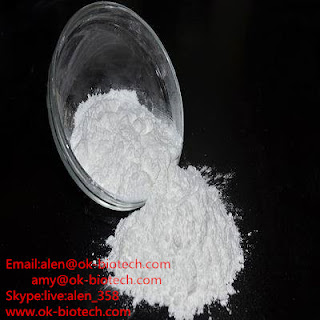Buy Anabolic Steroids
Anabolic Steroids
To strengthen the anabolic properties of testosterone, more than 100 synthetic steroid derivatives have been described for human purposes. The anabolic effect promotes protein synthesis, muscle growth and erythropoiesis. In clinical practice, substances with anabolic effect are needed to overcome various catabolic states. However, none of these compounds are devoid of androgenicity. Androgenic and anabolic properties of anabolic steroids cannot be totally separated. Therefore, it is more appropriate to use the term anabolic androgenic steroids (AAS).
Testosterone and its derivatives are well absorbed from the gastrointestinal tract but are rapidly metabolized during hepatic Þ rst-pass metabolism without reaching systemic circulation. Testosterone is inactivated primarily by the cytochrome P450 hepatic isoenzyme. To increase systemic availability, AAS are modified as injectable 17β-esters or orally administered 17α-alkylated steroids. Orally administered testesterone undecanoate also avoids hepatic metabolism because it is absorbed from the alimentary canal through the lymphatic system.
After absorption from the gastrointestinal tract during hepatic first-pass metabolism, testosterone and AAS undergo biotransformation and are partly excreted via bile to the faeces. Testosterone in systemic circulation is also prone to metabolism in the liver, and once excreted, the steroid can be reabsorbed from the gastrointestinal tract. In peripheral tissues, testosterone is susceptible to glucuronization to androsterone and etiocholanolone, two major metabolites of testosterone, which are excreted to urine.
In vivo, different AAS are also potential targets for aromatization and reduction. Since the AAS molecule is susceptible to such enzymatic conversion, it possesses various biological properties.
Steroids Action
The effects of AAS on genes and consecutive gene expression are poorly understood. Recently, human myostatin has been cloned and is considered to be a negative regulator of muscle growth. Basaria et al. (2001) speculated that AAS might act by inß uencing myostatin concentration. Further, all tissues are susceptible to androgen action. No tissues are devoid of androgen receptors, and all androgen receptors distributed throughout the body possess the same binding affinity for a particular steroid. Receptor-binding studies have not demonstrated marked differences between AAS in receptor-binding affinity. Young adolescents are more susceptible to androgen action of AAS because they possess a higher number of cytosol androgen receptors. Even with the biologically active unbound fraction of testosterone in circulation, androgen receptor sites are already saturated in striated muscles
Supraphysiological doses of AAS induce gain in muscle size and strength, even without concomitant exercise. At a supraphysiological dosage, AAS interacts with various receptors, including progesterone, estrogen, and mineralo- and glucocorticoid receptors. Supraphysiological doses of AAS have been speculated to mediate their anabolic action through interaction with glucocorticoid receptors by preventing glucocorticoids catabolic effect. Testosterone has in fact been shown to have a high affinity for glucocorticoid receptors and in vivo it acts as an antagonist to endogenous circulating glucocorticoids.
AAS lower the levels of certain hormone-binding proteins in circulation. Thyroxin, cortisol, sex hormone, growth hormone and D-vitamin-binding globulin concentrations in circulation are decreased after AAS administration. Alterations in carrier protein concentration levels may increase biologically active steroid concentrations. One could also hypothesize that AAS-mediated anabolism could be partly due to increased concentrations of circulating biologically active human growth hormone (GH) and insulin like growth factor-I (IGF-I), particularly when supraphysiological doses are used . Alén et al. (1987) found 5 to 60 times higher serum GH concentrations in subjects on AAS, even without concomitant use of exogenous GH. Local stimulation of IGF-I may be required in the process of anabolic action. Androgens are known to be needed in local production of IGF-I within the skeletal muscle. These could partly explain the mechanism of action of supraphysiological doses of AAS. On the other hand, these endings might also provide an explanation for the unpredictable adverse effects of AAS.
Clinical Indications
Anabolic androgenic steroids have established their usefulness in treating various types of anaemia, osteoporosis, androgen replacement therapy, muscle-wasting conditions, cachexia caused by various cancers, and HIV infection. Long-standing hypogonadism in adult males is associated with reduced bone remodelling and decreased bone formation. In treating muscle-wasting disorders with AAS, none of AAS preparations has proved to be superior to another. Recently, AAS have been studied for male andropause replacement therapy, but more studies are required before AAS can be used broadly for improving the
quality of life of ageing males.
quality of life of ageing males.
Dear Ms./Mr.,
Good day.
(Quality is our culture)
Alen Gao from Shenzhen OK Biotech Technology Co,.Ltd., China, professional for pharmaceutical intermediates,Steroid Hormone Powders or Chemical raw materials. Such as Flibanserin, Testosterone , Mesterolone, Tadalafil, Boldenone, Trenbolone, Methyltesterone, Tamoxifen Citrate,Clomiphene citrate,etc..
We have our own factary, the price will be very competitive. We also can ship to worldwide with safe package. With us your money is safe and your business in safe .
Hope to hear from you soon.



kaufen steroiden online Interesting stuff to read. Keep it up.
回复删除